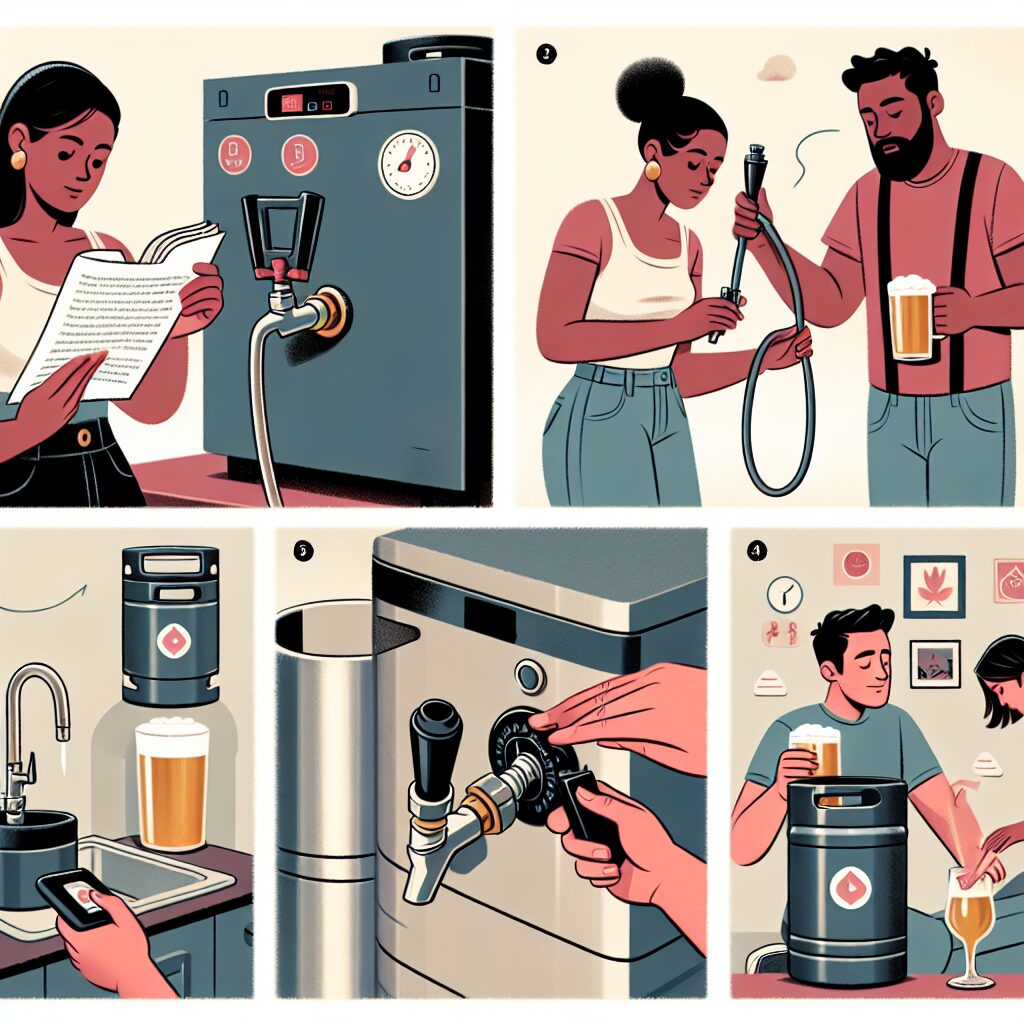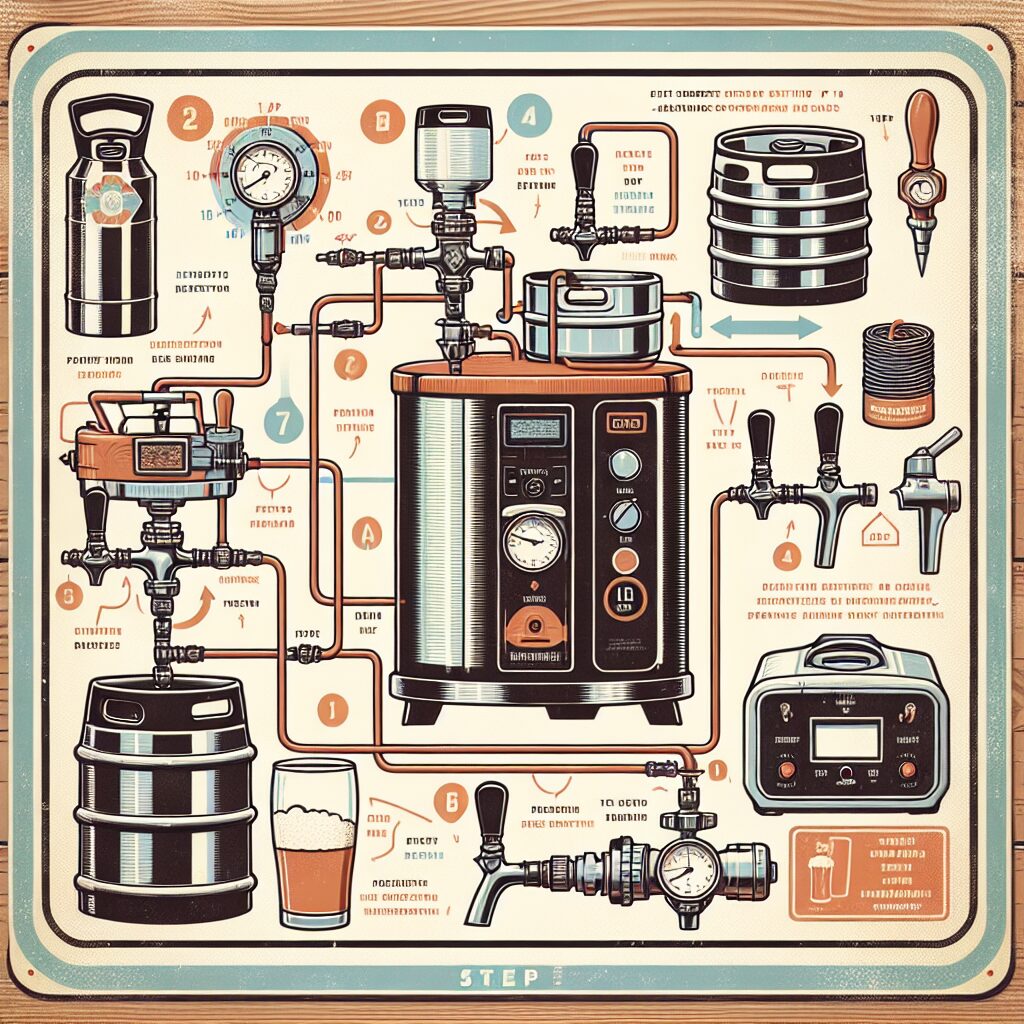As an Amazon Services LLC Associates Program participant, we earn advertising fees by linking to Amazon, at no extra cost to you.
Adjusting CO2 Pressure for Optimal Dispensing
Many folks think that a standard CO2 pressure setting works for all beers. I believe that adjusting the pressure based on beer style is key. For example, lighter beers might need around 10 PSI, while stouts could require more. This little tweak can make a huge difference in taste!
Some people rely solely on forced carbonation methods. But I think natural carbonation using sugar can create a creamier texture. This method takes patience but can yield fantastic results.
According to the KegWorks Blog, “Adjusting CO2 pressure according to beer styles ensures optimal carbonation.” This insight is spot on!
So, don’t just set it and forget it. Keep experimenting with those settings to find your perfect pour!
Common Kegerator Setup Mistakes to Avoid
Avoid these common pitfalls to ensure a flawless kegerator setup and enjoy your beer at its best.
- Don’t ignore temperature settings. Beer should be served between 36°F and 40°F for the best flavor.
- Placement matters! Keep your kegerator away from direct sunlight and ensure good airflow.
- Watch your CO2 pressure. Too high means foam; too low leads to flat beer. Adjust accordingly!
- Neglecting cleaning? Big mistake! Regularly clean your beer lines to avoid off-flavors.
- Don’t overlook keg handling. Transport kegs carefully to maintain their temperature and integrity.
- Assuming all beers should be ice-cold is wrong. Different styles have unique temperature requirements.
- Ignoring signs of trouble? Bad idea! Foamy pours or constant pressure adjustments indicate setup issues.
Jun 2, 2024 … What could possibly go wrong? A Summary of a Typical Kegerator Setup. A CO2 tank with regulator is connected to some reservoir (usually a keg) …
The Only Bubble(s) I Have High Interest for are from My Kegerator
Aug 17, 2020 … I do t want to wait 2-3 months only to find out they were wrong. … not denoted in the manual, so maybe the defrost symbol?), and there …
May 26, 2018 …Setup was fine – problem was a bad keg. I wonder how frequent of a problem that is. Methinks not very! Comment. Post Cancel. djc.
Problem with Guinness – spurting foam – Dispense Forum | Discuss …
Feb 12, 2023 … You MUST CLEAN the tube you're installing it onto. I've installed thousands of these valves and not one ever leaked! Just like any other gasket …
How to Add Freon/Refrigerant to a Refrigerator with a Piercing Valve …
Feb 23, 2022 … Steven Gilhooley rookie mistake that always have at least 8 kegs. … Kyle McSporran Thank you Not often, but they may become more common .
Perfect Draft Keg Tips | Is electric needed just to chill the keg,or to …
Best practices for kegerator placement and airflow
Here are some tips to avoid common kegerator setup mistakes related to placement and airflow.
- Keep your kegerator away from direct sunlight. Sunlight can heat it up, ruining your beer.
- Ensure proper airflow around your kegerator. Cramped spaces can cause overheating.
- Monitor temperature fluctuations. Use a thermometer to keep track of internal temps.
- Consider using an external temperature controller. It provides precise adjustments that built-in thermostats often miss.
- Treat your kegs with care during transport. Using a dedicated cooler helps maintain temperature.
- Invest in keg jackets. They keep your kegs cold longer, especially on the go.
Dec 10, 2022 … I setup a docker container on my NAS and got it running … Here's how you can avoid common mistakes in the consumer electronics industry.
Recognizing Signs of Kegerator Setup Issues
Have you ever noticed your beer pouring with way too much foam? That’s a classic sign your kegerator isn’t set up right. Temperature issues are often to blame. If your kegerator is too warm, your beer can lose carbonation, leading to a frustrating experience.
Another red flag? If you’re constantly adjusting the CO2 pressure without any luck, it’s time to investigate further. Most people think a simple pressure adjustment will fix everything, but it often points to deeper setup problems.
Keep an eye on your beer lines too. If they’re dirty, you’ll taste it. Regular cleaning is non-negotiable. Neglecting maintenance can ruin your beer’s flavor.
Some folks swear by the idea that all beer should be served ice-cold. I disagree. Different styles require different temperatures. Knowing this can make a huge difference in your beer experience.
As KegWorks suggests, “Most common issues with your kegerator can be traced back to improper temperature, improper pressure, or general cleanliness.” You can check out more tips on their blog here.
Lastly, if your kegerator is in a cramped space or direct sunlight, it’s time for a new spot. Proper airflow is crucial for optimal performance.

Oct 28, 2024 …AVOID these mistakes to protect your refrigerator from premature failure‼️ … This extremely dangerous outlet install is far too common!
Before 2014, server management was a much more manual and complex task. The concept of serverless computing was beginning to gain prominence, and AWS Lambda …
we call and approach to install the counterchaft. Still a working process, but in love with my corner. 296 Likes, TikTok video from Lifeonwillowcreek ( …
How to Build Small Dry Bar with Fridge in Game Room | TikTok
3 days ago … Half barrels are the most common. It's called a half barrel … when you're not putting beer kegs in there. This will fit up to two …
How Temperature Affects Beer Taste and Carbonation
Understanding how temperature impacts beer is key to avoiding common kegerator setup mistakes.
- Beer tastes best between 36°F and 40°F. Too cold? You miss flavors.
- Serving beer too warm leads to excessive foaming. Keep it cool!
- An external temperature controller can maintain ideal conditions consistently.
- Placement matters! Avoid direct sunlight and ensure good airflow.
- Regular cleaning of beer lines prevents off-flavors and maintains taste.
- Experiment with different beer styles to see how temperature affects them.
- Don’t fall for the myth that all beers should be ice-cold; adjust for style.
Recommended Temperature and Pressure Settings
Here are some key insights to avoid common kegerator setup mistakes. These recommendations ensure your beer is served perfectly every time.
- Keep your kegerator between 36°F and 40°F. This range is where beer tastes its best!
- Adjust CO2 pressure based on beer style. Generally, 12 PSI works for most beers.
- Consider using an external temperature controller. It provides better control than built-in options.
- Avoid placing your kegerator in direct sunlight. Sunlight can heat it up, ruining your beer.
- Ensure good airflow around your kegerator. Cramped spaces can lead to overheating.
- Regularly clean your beer lines. This prevents off-flavors and maintains the beer’s taste.
- Experiment with different beer styles. Each style has unique temperature and pressure needs.
Understanding the Ideal Kegerator Temperature
Most people think a kegerator’s temperature is just a number. I believe it’s the secret sauce for perfect beer! Beer tastes best between 36°F and 40°F. Too cold? You’ll miss out on flavors. Too warm? Hello, foamy mess!
Many assume that the internal thermostat is accurate. I think using an external temperature controller is a game changer. It gives you precise control, ensuring your beer stays at that sweet spot.
Placement matters too. Avoid direct sunlight and poor airflow. A well-ventilated area keeps your kegerator from overheating. Trust me, it’s worth the effort!
Cleaning is non-negotiable. I can’t stress this enough! Regularly clean your beer lines to prevent off-flavors. According to KegWorks, “Most common issues with your kegerator can be traced back to improper temperature, improper pressure, or general cleanliness.”
Consider experimenting with different beer styles. This can help you understand how temperature affects carbonation. It’s a fun way to enhance your beer experience!
Lastly, let’s talk about common myths. Many believe all beers should be served ice-cold. I think that’s a misconception! Different styles have unique temperature preferences that can elevate your tasting experience.
The Impact of Kegerator Positioning on Beer Quality
Many people think that any spot is fine for a kegerator. I believe that placement can make or break your beer experience. Keep it away from direct sunlight. Sunlight can heat up your kegerator, ruining your beer.
Most folks underestimate airflow. A cramped space can lead to overheating. Ventilation is key! Ensure your kegerator has enough space around it.
People often overlook temperature fluctuations. If your kegerator is near a heat source, it can affect the beer’s quality. I suggest using a thermometer to monitor the internal temperature.
Some enthusiasts swear by using an external temperature controller. This can provide precise adjustments that the built-in thermostat might miss. According to KegWorks, “Most common issues with your kegerator can be traced back to improper temperature.”
Let’s talk about keg handling too. Treat your kegs with care. Mishandling can lead to foaming issues and carbonation loss. Using a dedicated cooler during transport can help maintain temperature.
Consider investing in keg jackets. They keep your kegs cold longer, especially during transport. It’s a smart move for any serious beer lover!
Lastly, understand that not all beers are served the same way. Different styles have unique temperature needs. Adjust your setup accordingly!
Importance of Cleaning Beer Lines Regularly
Cleaning your beer lines is non-negotiable. I can’t stress this enough! If you neglect this task, you’re inviting off-flavors into your beer.
Most people think cleaning is a hassle, but I believe it’s a simple ritual that pays off. Regular cleaning prevents buildup that can ruin the taste.
According to KegWorks, “Most common issues with your kegerator can be traced back to improper temperature, improper pressure, or general cleanliness.” This highlights how crucial it is to keep those lines spotless!
Some enthusiasts suggest using a dedicated cleaning solution. I think this is a game-changer because it effectively removes stubborn residue. Plus, you can easily create a cleaning schedule to make it a breeze.
Don’t forget to check the CO2 pressure too. It’s intertwined with line cleanliness. If lines are dirty, it can impact how your beer pours.
For those who think cleaning is just a chore, think again! Regular maintenance leads to a better beer experience. It’s that simple.
Lastly, consider this: a clean kegerator means better beer quality. If you want to enjoy that perfect pint, make cleaning a priority!



What is the ideal temperature range for serving beer?
Beer tastes best between 36°F and 40°F. Too cold? You miss flavors. Too warm? Hello, foamy mess!
Many folks think the built-in thermostat does the job. I believe using an external temperature controller gives you precise control. This keeps your beer at that sweet spot consistently.
Placement matters too! Avoid direct sunlight and ensure good airflow. A well-ventilated area keeps your kegerator from overheating.
Cleaning is non-negotiable. Regularly clean your beer lines to prevent off-flavors. According to KegWorks, “Most common issues with your kegerator can be traced back to improper temperature, improper pressure, or general cleanliness.”
Experimenting with different beer styles can help you understand how temperature affects carbonation. It’s a fun way to enhance your beer experience!
How should I position my kegerator for best performance?
Placement is everything! I believe keeping your kegerator away from direct sunlight is a must. Sunlight can heat it up, ruining your beer.
Airflow is key. Cramped spaces can lead to overheating. Make sure there’s enough space around your kegerator.
Many think just setting it up is enough. I think monitoring temperature fluctuations is crucial. Use a thermometer to keep track of internal temps.
Most people rely on built-in thermostats. But I think using an external temperature controller is a smarter choice. It gives you better control over your beer’s environment.
Transporting kegs? Treat them with care! I suggest using a dedicated cooler to maintain temperature. Investing in keg jackets can help too.
Finally, not all beers are served the same way. Different styles need different temperatures. Adjust your setup accordingly!
What CO2 pressures are typically recommended for different beers?
Many people think a standard CO2 pressure setting works for all beers. But I believe adjusting the pressure based on beer style is key. For example, lighter beers might need around 10 PSI, while stouts could require more.
Most folks assume that any pressure will do. I think that’s a mistake! The right pressure ensures your beer is carbonated perfectly, avoiding those annoying foamy pours.
According to the KegWorks Blog, “Adjusting CO2 pressure according to beer styles ensures optimal carbonation.” This insight is spot on!
Some enthusiasts even explore natural carbonation methods, like using sugar. This can create a creamier texture that’s hard to beat.
How often should I clean the beer lines in my kegerator?
Many folks think cleaning beer lines is a hassle. I believe it’s a must-do! Neglecting this task invites off-flavors into your beer.
Cleaning should happen regularly, ideally every two weeks. This keeps your beer tasting fresh and delicious.
According to KegWorks, “Most common issues with your kegerator can be traced back to improper temperature, improper pressure, or general cleanliness.”
Some enthusiasts suggest using a dedicated cleaning solution. I think this is smart because it effectively removes stubborn residue.
Don’t forget, a clean kegerator means better beer quality. Make cleaning a priority!
What common mistakes should I avoid when setting up my kegerator?
Don’t overlook temperature settings. Beer should be served between 36°F and 40°F for the best flavor. Too cold? You miss flavors. Too warm? Hello, foamy mess!
Placement matters! Keep your kegerator away from direct sunlight and ensure good airflow. Cramped spaces can lead to overheating.
Watch your CO2 pressure. Too high means foam; too low leads to flat beer. Adjust accordingly! Many think a standard setting works for all, but I disagree.
Regularly clean your beer lines. Neglecting this leads to off-flavors. I can’t stress this enough!
Don’t assume all beers should be ice-cold. Different styles have unique temperature requirements. Adjust your setup accordingly!
For a fresh perspective, consider using an external temperature controller. It gives you precise control, ensuring your beer stays at that sweet spot.
As KegWorks says, “Most common issues with your kegerator can be traced back to improper temperature, improper pressure, or general cleanliness.” Check their blog for more tips.
How can I tell if my kegerator is set up incorrectly?
Foamy beer? That’s a red flag! Temperature issues are often the culprit. If it’s too warm, carbonation drops, and you’re left with a mess.
Struggling with constant CO2 pressure adjustments? That usually signals deeper setup problems. Don’t just keep cranking it up; investigate further.
Dirty beer lines? You’ll taste it immediately. Neglecting maintenance ruins flavor. Regular cleaning is key!
And here’s a myth: all beer should be ice-cold. Nope! Different styles need different temperatures. Know your brews!
As KegWorks puts it, “Most common issues with your kegerator can be traced back to improper temperature, improper pressure, or general cleanliness.” Keep an eye on your setup!
What alternative methods can I use to maintain beer quality during transport?
Most folks think keeping kegs in a cooler is enough. I believe using a dedicated cooler with ice packs is way better! This keeps your keg at the right temperature and avoids foaming issues.
Some enthusiasts swear by keg jackets. They help maintain cold temperatures for longer, especially during transport. It’s a smart investment for anyone serious about their beer.
According to SSKeg, “Handling your kegs with care can significantly enhance your overall beer experience.” So, treat those kegs right, and you’ll enjoy better beer every time!
As an Amazon Services LLC Associates Program participant, we earn advertising fees by linking to Amazon, at no extra cost to you.



